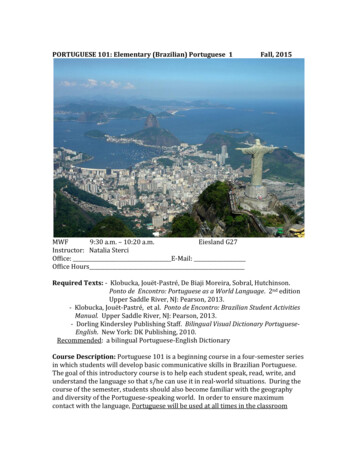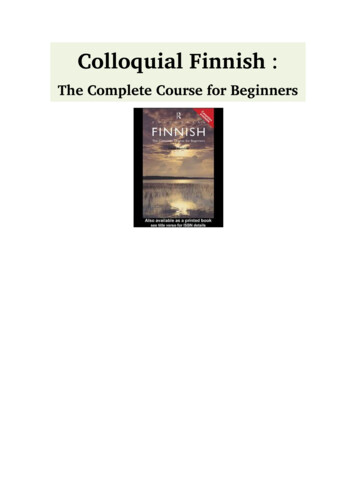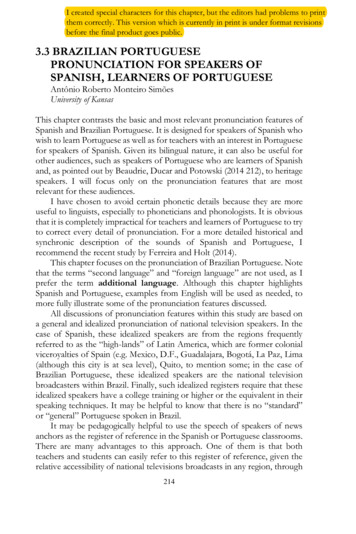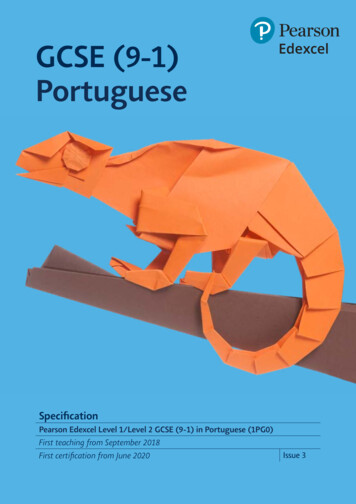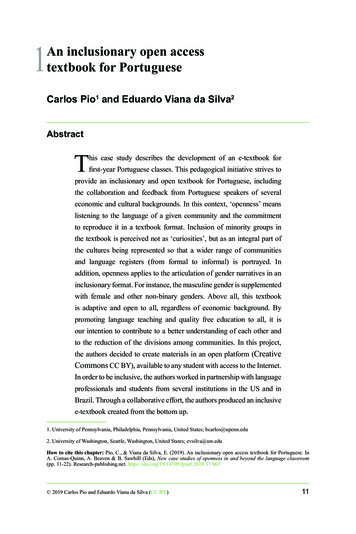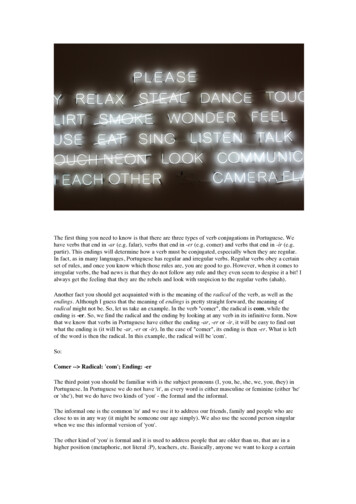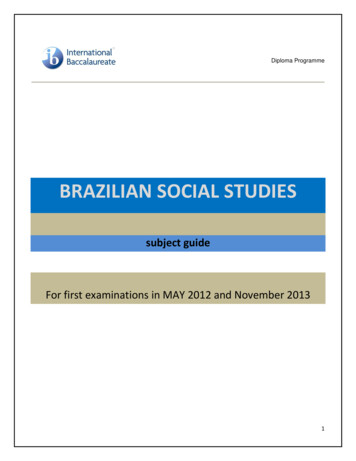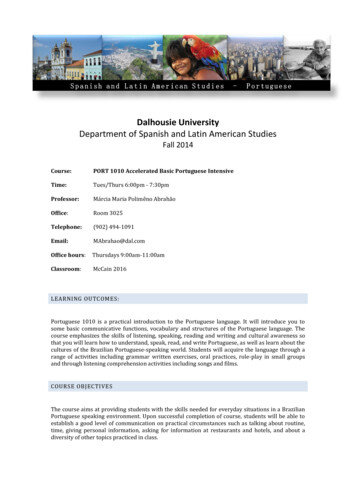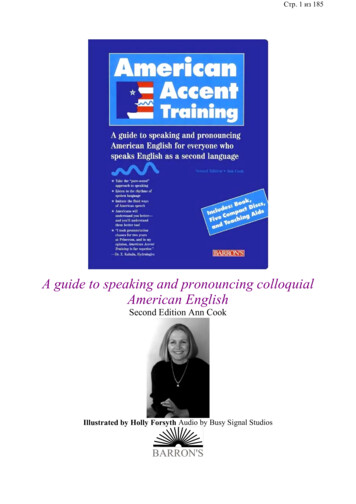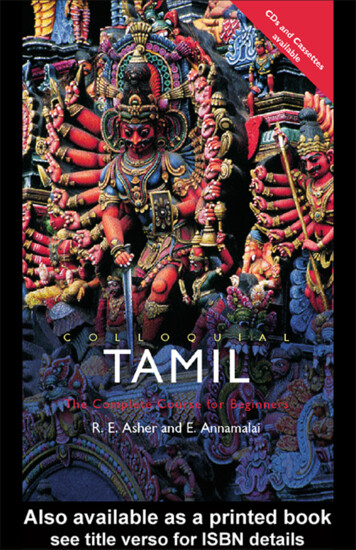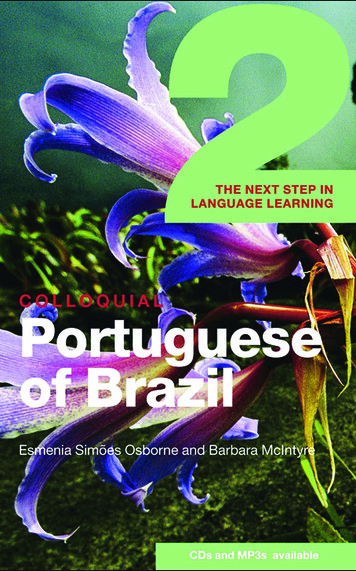
Transcription
2Colloquial Portuguese of Brazil
The Colloquial 2 SeriesSeries adviser: Gary King2The following languages are available in the Colloquial 2 series:ChineseDutchFrenchGerman (forthcoming)ItalianPortuguese of BrazilRussianSpanishSpanish of Latin AmericaAccompanying CDs are available for the above titles. They can be orderedthrough your bookseller, or send payment with order to Taylor & Francis Ltd/Routledge Ltd, Bookpoint, Unit T1, 200 Milton Park, Abingdon, Oxon OX14 4TA,UK or to Routledge Inc, 270 Madison Avenue, New York, NY 10016, USA.
2Colloquial Portuguese of BrazilThe next step in language learningEsmenia Simões Osborne andBarbara McIntyre
First published 2008by Routledge2 Park Square, Milton Park, Abingdon, Oxon OX14 4RNSimultaneously published in the USA and Canadaby Routledge270 Madison Ave, New York, NY 10016This edition published in the Taylor & Francis e-Library, 2008.“To purchase your own copy of this or any of Taylor & Francis or Routledge’scollection of thousands of eBooks please go to www.eBookstore.tandf.co.uk.”Routledge is an imprint of the Taylor & Francis Group, an informa business 2008 Esmenia Simões Osborne and Barbara McIntyreAll rights reserved. No part of this book may be reprinted or reproducedor utilised in any form or by any electronic, mechanical, or other means,now known or hereafter invented, including photocopying and recording,or in any information storage or retrieval system, without permission inwriting from the publishers.British Library Cataloguing in Publication DataA catalogue record for this book is available from the British LibraryLibrary of Congress Cataloging in Publication DataMcIntyre, Barbara, 1954–Colloquial Portuguese of Brazil 2 : the next step in language learning /Barbara McIntyre & Esmenia Simões Osborne.p. cm. – (The colloquial 2 series)Includes index.1. Portuguese language – Textbooks for foreign speakers – English.2. Portuguese language – Spoken Portuguese – Brazil. I. Osborne, EsmeniaSimões, 1949– II. Title, III. Series.PC5075.E5M385 2007469.82′421–dc222007041454ISBN 0-203-88030-7 Master e-book ISBNISBN13: 978-0-415-43097-5 (book)ISBN13: 978-0-415-43099-9 (audio CDs)ISBN13: 978-0-415-43098-2 (pack)
ContentsAcknowledgementsHow to use this bookviiviiiUnit 1Entre amigosBetween friends1Unit 2O BrasilBrazil16Unit 3Estou em férias!I’m on holiday!30Unit 4Aluga-seTo rent/to hire46Unit 5Dias santos e feriadosReligious and public holidays64Unit 6Saúde e nutriçãoHealth and nutrition80Unit 7Educação e culturaEducation and culture95Unit 8Esportes e religiãoSports and religion110Unit 9Mercado de trabalhoThe job market122Unit 10Imigração e desenvolvimento econômicoImmigration and economic development137Unit 11Política, comunicação e mídiaPolitics, communication and the media151Unit 12A ecologia e os índios brasileirosEcology and the Brazilian Indians166
vi ContentsSuggestions for further readingGrammar referenceKey to exercisesGrammar indexTopic index179180197234236
AcknowledgementsWe acknowledge permission fromCarlos Magno do Nascimento, President of Climatempo, for the useof the weather forecast in Unit 1.Carolina Simões Ribeiro, for her invaluable help and also for thephotos of the church in Unit 5 and the exotic bird in Unit 12.A special thanks to Claudia Kohler and Daniela Soares at GreenpeaceBrasil, for the lyrics of Samba pela Vida, courtesy of the composersLeo Viana and Rubens da Costa.Finally, our grateful thanks go to João Sampaio, our colleague andfriend, for his enthusiasm and support for this book and to BillOsborne for his generous technical assistance.Every effort has been made to trace and acknowledge the ownershipof copyright.
How to use this bookBem-vindo to Colloquial Portuguese of Brazil 2! If you are studyingalone or with the help of a teacher, wanting to build on the knowledge you already have of Brazilian Portuguese and to achieve a morein-depth understanding of both the language and culture of Brazil,this book can help you.At the beginning of each of the twelve units a list of bullet pointstells you the grammar and topics to be covered. Language points areclearly presented throughout the units and a brief Grammar referenceis also provided so that you can review basic language structures. Alllanguage points in the units are followed by one or more exercises ofvarious kinds to allow you to apply what you have learned andanswers to these exercises can be found in the key at the end of thebook. Other exercises in the book under the headings Vamos falaror Vamos escrever don’t always have an answer in the key as theyare more improvisational in style and will help to draw out whatyou already know of the language. We hope you will find them funand helpful to do. Don’t forget too, a special web site supportsColloquial Portuguese of Brazil 2. At www.routledge.com/colloquials/portugueseofbrazil you will find a variety of useful exercises to practise the language, plus links to other useful language websites.Language is of course inseparable from the culture and way of lifeof its speakers. The topics in each unit explore the rich diversity ofBrazil through interesting and practical dialogues, reading texts andinterviews, many of which are recorded on the accompanying CDs.Cultural notes throughout the book as well as the Você sabia? sections in each unit (1–6 in English and 7–12 in Portuguese – withtranslations in the key for Units 7–9) provide a glimpse of the customs and culture of Brazil. Throughout the book we also refer tonumerous web sites where you can explore Brazilian culture in greaterdetail.On your CDs you will find the dialogues, situations, interviewsand texts featured in the book. Try and listen to the recordings asmuch as possible to practise your comprehension and become familiar with the sounds of the language. Don’t worry if you cannotunderstand everything at first as this is quite natural. Play your CDs
How to use this book ixwhenever you have an opportunity – in the car, on the bus or wherever. There are also plenty of speaking exercises on the recordings tolet you practise and repeat the language. You could also try recording yourself reading out some of the dialogues or texts then compareyour pronunciation with the recordings. All of this will help to deepenyour fluency in the language.We hope this book will provide you with a springboard to extendand develop your growing skills in Brazilian Portuguese.Boa sorte!
Allie
Unit 1: Entre amigos 1Entre amigos1In this unit you will learn about:wwwwwwwgreetings and friendly expressionsusing the imperative (1)using ser and estarusing muito and poucochecking the weather forecasta gente nósuses of ter and haverDialogue 1(CD1; 1)American student Peter visits some Brazilian friends who have settledin Miami.Exercise 1Listen to the dialogue and answer these questions in English:12345Whereabouts is André and what is he doing?What news does Peter have for his friends?Why would it be good for Peter to meet Renata?What does Renata say about entertainment in São Paulo?Renata is proud to be paulista – true or false?ESTELAPETERESTELAANDRÉPETEROlá Peter, tudo jóia? Vamos entrar. Fique à vontade.Oi Estela, tudo beleza? Onde está o André? Tenho boasnotícias.Ele está na cozinha preparando as saladas. Vamos lá.Olá Peter, já recebeu a confirmação do seu estágio no Brasil?É isso aí, André. Estou muito feliz!
2 ANDRÉUnit 1: Between friendsQue legal, Peter! Parabéns! Você vai para São Paulo, não émesmo? Então você tem que conhecer a Renata. Ela podelhe dar muitas dicas porque ela é paulistana.They all go into the EROi pessoal! Aqui está mais um estagiário indo para o Brasil!Olá Peter! Eu sou a Renata. Onde é que você vai fazer o seuestágio?Vou trabalhar com uma rede de televisão em São Paulo, naárea de mídia e produção de filmes. André me disse quevocê é paulistana . . .Nascida e criada! Você vai gostar de lá porque divertimentoé o que não falta na cidade. É a maior metrópole e o maiorcentro financeiro da América Latina. São Paulo é conhecidacomo a Nova York dos Trópicos, sabia?Ouvi dizer que é o estado brasileiro onde tem mais indústrias.Com certeza. É a maior potência industrial da América doSul! Eu tenho orgulho de ter nascido neste estado. Mas mefala dos seus planos de trabalho no Brasil . . .Com licença Renata, o churrasco está pronto. Sirvam-se. Peter,você pode pegar as cervejas na geladeira?Deixa comigo. Eu já volto, Renata.In colloquial language Brazilians place object pronouns (‘me, you, us/to me, to you, to us’, etc.) before the verb and not after it (as inEuropean Portuguese).Example from Dialogue 1:André me disse que vocêé paulistana.André tells me you are from São Paulo.You can read more on object pronouns and their position in Unit 10.São Paulo state is the richest state in South America. São Paulocity, nicknamed Sampa by its 15 million or so inhabitants, isBrazil’s most modern and cosmopolitan city. People born inSão Paulo city are called paulistanos and those born in anyother part of São Paulo state are known as paulistas.
Unit 1: Entre amigos 3Vocabulary tudo jóia?fique à vontade(tudo) beleza?é isso aíque legal!não é mesmo?oi pessoal!nascida e criadaouvi dizer que . . .pode pegar?deixa comigohow are things? (coll.) jóia jewelmake yourself at homehow are things? (coll.) beleza beautythat’s rightgreat!isn’t that right?hey everyone!born and bredthey say that . . .can you get?leave it to meExercise 2(CD1; 2)Vamos falar e escrever1 Listen again to Dialogue 1 then role-play the parts of some or allof the characters. If possible, make your own recording.2 Revise the present indicative of irregular verbs ser, estar, ter andir then use these verbs to write a brief description of Peter’s life:Peter é americano . . . etc. Compare what you have written to theanswer in the key.Exercise 3Translate these sentences into Portuguese:1234Hello, please come in. How are things? Do you have good news?But tell me about your internship. What are your plans?Hi everyone, make yourselves at home.You must meet Renata. That’s right, she told me she is from SãoPaulo.5 I heard that you are going to work in the media.6 Please, help yourselves. The salad and the barbecue are ready.7 Can I get a Brazilian beer from the refrigerator?
4 Unit 1: Between friendsExercise 41 Revise the preterite of regular verbs and the preterite of irregularverb dizer.2 Find and underline any verbs in the preterite in Dialogue 1.Exercise 5(CD1; 3, 4)Vamos falarYou meet a person in a bar and get chatting to them. Ask inPortuguese:What’s your name? Where were you born? Are you here on holiday? Are there other English people working for your company?What do you think of Brazilian cuisine?If you have the CD, listen to ‘Meeting new friends’ – a similar dialoguebetween Sarah and Rafael.Language point 1 Using the imperative (1)The imperative is used for commands, instructions or advice.1 The affirmative imperative (familiar command forms) tu and vós*:Formation: from the tu and vós persons of the present indicative with the final s*- of the verb removed:comprar to buyvender to sellpartir to leavecompra! (tu)comprai! (vós)vende! (tu)bebei! (vós)parte! (tu)parti! (vós)Notes*Exception is ser ‘to be’: sê (tu); sede (vós).* vós is usually restricted to the language of prayers, speeches and classical literature.
Unit 1: Entre amigos 52 The other persons of the imperative, você, nós and vocês, arebased on the present subjunctive:comprar to buyvender to sellpartir to leavecompre! (você)compremos! (nós)comprem! (vocês)venda! (você)vendamos! (nós)vendam! (vocês)parta! (você)partamos! (nós)partam! (vocês)3 The forms for the negative imperative are also taken from thepresent subjunctive:Não toques (tu), toque (você), toquemos (nós), toqueis (vós),toquem (vocês)! Don’t touch!In colloquial language, don’t be surprised if you hear the presentindicative used for negative commands instead of the presentsubjunctive:Não toca (tu) em nada.instead of Não toques (tu) em nada.Brazilians tend to mix the imperative forms tu and você, so it is verycommon to hear:Maria, chame (tu) o teu marido.grammatically correct:(chame is the form for você)Maria, chama o teu marido.Fica (você) quieta!grammatically correct:(fica is the form for tu)Fique (você) quieta!Exercise 6aUnderline any verbs in the imperative in Dialogue 1 and also writedown their infinitives.b Translate these using the imperative:1 Come in! (você)4 Let’s eat! (nós)2 Don’t prepare the drinks! (tu) 5 Don’t sell! (vocês)3 Work harder! (vós)6 Repeat! (tu)More on the imperative in Unit 6.
6 Unit 1: Between friendsExercise 71 Two young friends are out clubbing. Before reading the text,match these expressions from it:1234O que há de novo.Não deu prá ir.Derramei sua bebida?Há quanto tempo, amigão.SAMUELBETOSAMUELBETOSAMUELBETOSAMUELDJI spilled your drink.Long time no see.What’s new?I couldn’t go.Há quanto tempo, amigão! Tudo legal?E aí, como é que é?Diz aí, meu irmão! O que há de novo?Desculpa, derramei sua bebida.Fica frio, mano!Desculpa cara, não deu prá ir na sua casa ontem.Falou colega, não tem galho!.É isso aí galera! Todo mundo sambando!Vocabulary amigão (m)cara (f)prá paragalho (m)galera (f)ir à danceteria/baladaman (coll.) lit.: ‘big friend’man (coll.) lit.: ‘face’to/forbranchpeople (coll.) lit.: ‘galley’to go clubbing/dancing2 Apart from não tem galho, what other ways might you say ‘noproblem’ in Portuguese?Text 1(CD1; 5, 6)Local government in São Paulo is always on the lookout for ways toboost commerce in the city, as with this new proposal: ‘Full-tanktourism’.
Unit 1: Entre amigos 7Exercise 8aBefore reading the text, match these phrases from it:1234Trazer pessoasPeople who stayAs pessoas que se hospedam To be eligible for the discountsCriar um fluxoTo bring peoplePara ter direito aos descontos To create a flowb Now listen to and read the text then answer these questions inEnglish:1 A discount of up to 60 per cent is available to whom?2 Which other commercial outlets will participate in thepromotion?3 What has to be produced in order to qualify for any of thediscounts?Turismo de tanque cheioO governo municipal criou uma proposta para beneficiar o comérciopaulistano, intitulada turismo de tanque cheio. A idéia é trazerpessoas que moram fora da região metropolitana para a capital.De acordo com esta iniciativa, as pessoas que se hospedam emhotéis da capital paulista recebem desconto de até 60 por cento.A intenção desta medida é criar um fluxo entre restaurantes,lojas, agências de turismo e parques temáticos que estão participando da promoção. Para ter direito aos descontos, o visitante temque apresentar a nota fiscal do posto de gasolina pertencente àrede credenciada.Language point 2 Ser and estarThere are two verbs for ‘to be’ in Portuguese, ser and estar.In general, ser expresses a permanent quality or characteristic –what something or someone is whilst estar denotes a temporary state– how something or someone is. Look at these two examples fromDialogue 1:
8 Unit 1: Between friendsOnde está o André? Where is André? (temporary location – estar)Ela é paulistana.She is paulistana. (permanent characteristic– ser)Ser (permanent)Estar (temporary)Ela é alta.She is tall. (She will never be small.)Estou feliz.I am happy (but I may be sad later).O carvão é preto.Coal is black.A sopa está fria.The soup is cold.Onde é o prédio da Comgás?Where is the Comgás building?A geladeira está na cozinha.The refrigerator is in the kitchen.Peter é americano.Peter is American.Peter está em Miami.Peter is in Miami.The verb ser is also used to express possession, time and origin:Aquela casa é minha.É meio-dia.O Pelé é de Minas Gerais.That house is mine.It’s midday.Pelé is from Minas Gerais.The verb ser is also used in certain impersonal expressions and thepassive voice:É necessário repetir muitas vezes.It’s necessary to repeat it many times.O documentário foi filmado no Rio. The documentary was filmed in Rio.Exercise 9Fill in the gaps using ser or estar:1234567Meu nome Peter. Eu americano.Onde o André? Ele na sala vendo TV.André e eu amigos.Renata, onde o seu carro? na garagem.Renata e Estela brasileiras.Eu não sei onde a universidade.As facas e os garfos limpos. A saladapronta.8 E as cervejas, onde ? nageladeira.
Unit 1: Entre amigos 9Language point 3 Muito and poucoMuito used as an adverb – ‘very/too/a lot/much’, is invariable. Itmodifies a verb, an adjective or even another adverb:very:Estou muito aborrecida.Você samba muito bem.I am very upset.You dance the samba very well.too:As camisetas são muito grandes. The t-shirts are too big.a lot:Choveu muito.It rained a lot.much:Não há muito o que dizer.There is not much to say.Muito used as an adjective – ‘many/a lot of’, agrees with the nounreferred to:São Paulo tem muitas atrações.Ele pode lhe dar muitosconselhos.São Paulo has many attractions.He can give you a lot ofadvice.Pouco used as an adverb – ‘little’, is invariable. It modifies a verb, anadjective or even another adverb:Conhecemos pouco o Pantanal.Fica mais um pouco.We know little about thePantanal.Stay a little longer.Pouco used as an adjective – ‘few’ ( not many) agrees with thenoun:Poucos alunos vieram.Havia pouca gente lá.Few students attended.There were few people there.
10 Unit 1: Between friendsExercise 10aFill in the gaps with the correct adverb or adjective:123456Os programas da Globo são bons.Há jornalistas brasileiros no exterior.As praias de Cabo Frio são limpas.Os estudantes universitários têm dinheiro.Há sobreviventes da Primeira Guerra Mundial.Vieram pessoas ao churrasco.(very)(many)(very)(little)(few)(few)b Now translate the sentences into English.Dialogue 2(CD1; 7)Carolina bumps into a friend, Luiz. They start chatting about holidays and the weather.Exercise 11aMatch these sentences before reading the dialogue:1 O tempo estava firme.2345The temperature is going tofall.Caiu uma chuva muito forte.There was a lot of fog on themotorway.A temperatura vai baixar.It rained heavily.Tinha muita neblina na estrada. We have to wear warmclothes.A gente tem que pôr agasalho. The weather was settled.b Listen to then read the dialogue and answer these questions inPortuguese:1 How does Luiz describe the weather in Campinas before 4o’clock in the afternoon?2 When and with whom did Carolina go on holiday last year?3 What was the weather like on the way to Campos do Jordão?4 Why does Carolina advise Luiz not to go to São Paulo?
Unit 1: Entre amigos 11CAROLINA Oi Luiz, você sumiu! Por onde tem andado?LUIZEstava em férias em Campinas. No sábado tivemos um diatípico de verão, céu azul e muito sol. Depois das quatro datarde, o tempo mudou, ficou nublado e caiu uma chuvamuito forte, com trovões e relâmpagos.CAROLINA Em agosto do ano passado fui com um amigo a Camposdo Jordão. Fez muito frio e tinha muita neblina na estrada.No dia seguinte o tempo estava firme, com muito sol mas atemperatura máxima foi de 20 C.LUIZAinda bem que aqui no interior está quente. Eu detestoquando a temperatura cai e a gente tem que pôr agasalho.CAROLINA Então não vá a São Paulo hoje porque a temperatura vaibaixar para 17 C à noite. Você sabe como o clima da capital é.Vocabulary você sumiuonde tem andado?o tempo mudoua genteyou disappearedwhere have you been?the weather changedweCampos do Jordão is the highest mountain town in Brazil(1.628m) and is where Paulistanos go in winter. In July, theFestival de inverno de música erudita (Winter Festival of EruditeMusic) is held there.Exercise 12According to the weather map of São Paulo state, what is the minimumand maximum temperature for Campinas and which city shows thewarmest weather?
12 Unit 1: Between friendsPrevisao do Tempo (tilde on the ‘a’ of Previsao)Exercise 13Find the Portuguese equivalents for the words inside the cloud. Usethe map above as a guide.overcastfrostsun with very heavy rainrain with thundersunny with cloudscloudy with rainsunnyEstações do anoFrom ToPrimavera Spring22/09–21/12 VerãoOutonoAutumn/fall 22/03–21/06 InvernoFrom ToSummer 22/12–21/03Winter22/06–21/09
Unit 1: Entre amigos 13Exercise 14Vamos escreverImagine that you are a meteorologist (metereologista) from the Diárioda Bahia. Go to www.climatempo.com.br then write a brief reportabout today’s weather in Salvador. Mention the seasons above. Startby saying. ‘Hoje vamos ter um bonito dia de primavera em todo oestado da Bahia . . .’Exercise 15Vamos falarYou are in an internet chat room (sala de bate-papo). A Brazilianboy/girl, from Ipanema enters the room and asks you about theweather in Los Angeles/London, etc. (your choice). Give youranswers: aqui está frio/calor and ask: como está o tempo ai?/estácalor? (Use Dialogue 2 for guidance.)Language point 4 A gente is a colloquial substitute for nós ‘we’ and ‘us’. It takes thesingular form of the verb:We are in a hurry.A gente está com pressa.( Nós estamos com pressa.)Are you coming with us? Você vem com a gente? Você vem conosco?)( Remember that gente without the article a people.Há muita gente nas There are many people in the big cities.grandes cidades.Expressions using gente:Eu também sou gente! I’m as good as anyone!O Luíz é gente fina!Luíz is a great person!Gente! Gosh!Ele é gente boa. He’s a nice person.Ela virou gente. She grew up.Gente grande. Grown-ups.
14 Unit 1: Between friendsLanguage point 5 Haver and terto have1 Haver expresses ‘there is/are’, ‘there was/were’ and ‘to exist’. Ithas no plural form:Há uma abelha na minha sopa! There is a bee in my soup!Há três restaurantes nesta rua. There are three restaurants in thisstreet.Havia muita gente na festa?Were there a lot of people at theparty?Havia muitos alunos na classe. There were many students in theclass.O filme foi tão triste, nãoThe film was so sad, there wasn’thouve quem não chorasse.a dry eye in the house.In the spoken language preference is given to the verb ter and nothaver:Tinha muita gente na festa?Não tem toalhas no banheiro.O filme foi tão triste, não tevequem não chorasse.(instead of havia)(instead of há)(instead of houve)2 Haver expressing: ‘how long’, ‘for a long time’, ‘for’ plus a periodof time, or ‘ago’. (interchangeable with fazer):Há (faz) quanto tempo você mora aqui?How long have you been living here?Há (faz) muito tempo que ele não come carne.He hasn’t eaten meat for a long time.Não via o namorado havia (fazia) dois meses.She hadn’t seen her boyfriend for two months.Fui ao Brasil há (faz) cinco anos.I went to Brazil five years ago.3 Idioms using haver:O que é que há?Haja o que houver.O que houve?Não houve nada!What’s the matter?Come what may.What’s wrong/what happened?Nothing’s wrong/nothing happened!
Unit 1: Entre amigosHei de vencer!O que há de novo? 15I will win!What’s new?4 Idioms using ter:tenho vontade de . . .Você tem certeza?tenha paciência.O que é que tem?Não tenho culpa de nada.Isso não tem nada a ver.Tem gente aí?I feel like . . .Are you sure?Be patient.What’s wrong?It’s not my fault.It has nothing to do with . . .Is anybody there?Exercise 16Fill in the gaps with the correct form of haver or ter:1234567891011Eles não educação.Vocês condições de trabalhar?quanto tempo você trabalha para essa empresa?Luiz não medo de cachorros.Ela não ia a Ilhabela algum tempo.Moro em Piracicaba mais de 10 anos.Confia em mim, me conta o que .Nós não pressa.Já lhe contei tudo. Não nada de novo.Está chorando . . . sabe o que com ela?Desculpe, mas não vagas.Você sabia?Churrasco is a typical Brazilian meal. It originated in the PampasGaúchos (Rio Grande do Sul Plains). For Brazilians any occasion isan excuse to celebrate with a barbecue. Steak houses, ChurrascariasRodízio, are the most popular restaurants in Brazil. Why rodízio?Because the waiters keep going round the tables serving slices of meaton to your plate. Brazilian churrascarias have become fashionable inmany countries around the world. Is there one in your country?
16 Unit 2: BrazilO Brasil2In this unit you will learn about:wwwwwwgeographical facts and figuresmaking comparisonsdefinite and indefinite articlespassive voice: ser plus past participleuses of ficardescribing placesText 1(CD1; 9)The territory of Brazil covers over 8 million square kilometres andthere are over 7,000 kilometres of coastline.Exercise 1aRead the text, check the vocabulary below then listen to therecording.b Say whether these are true or false:1 The south is the least populated region.2 The majority of the indigenous population is concentrated onthe coast.3 Brazil shares a border with Ecuador and Chile.4 There are only four other countries larger than Brazil.5 The north is the largest area of Brazil.
Unit 2: O Brasil 17RoraimaAmapáParáAmazonasMaranhãoCearáRio Grandedo ondôniaSergipeBahiaMato GrossoBrasilia(DF)Região NorteRegião NordesteGoiásMinas GeraisMato Grossodo SulEspírito SantoSão PauloRegião Centro-OesteParanáSanta CatarinaRegião SudesteRegião SulRio de JaneiroRio Grandedo SulO BrasilO Brasil é tão grande quanto os Estados Unidos da América,excluindo o Alasca. Todas as nações do continente sul-americanofazem fronteira com o Brasil com exceção do Equador e do Chile.Situado na América do Sul, o Brasil é o quinto maior país domundo em extensão territorial e está dividido em cinco regiões:Norte, Nordeste, Centro-Oeste, Sudeste e Sul.A região Norte ocupa 42 por cento do território nacional. Apesarde ser a região menos habitada do Brasil é onde se concentra amaioria da população indígena brasileira.A língua oficial do Brasil é o português mas o sotaque e aentonação são diferentes do português falado em Portugal.A raça brasileira é uma mistura de três raças: o índio, o africanoe o português. Esta miscigenação fez do Brasil um país culturalmente rico e, ao mesmo tempo, único.
18 Unit 2: BrazilVocabulary tão grande quantoexcluindofazem fronteira comcom exceção doo quinto maiorestá dividido emocupaapesar de serconcentrarpopulação indígenasotaque (m)entonação (f)miscigenação (f)as big asexcludinghave borders withwith the exception ofthe fifth largest *is divided intooccupiesin spite of beingto concentrate/gatherindigenous populationaccentintonationmiscegenation*See the Grammar reference for more on numbers.Play a game about Brazilian states on this web site: www.cambito.com.br/games/brasil.htmCheck this site to learn more about Brazilian regions: http://www.brcactaceae.org/brazil.htmlExercise 2This article contains some inaccurate statements about Brazil.1 Underline the two correct statements.2 Write down the statements correctly in English.O Brasil é mais ou menos a metadedo Alasca. Na verdade é um país deproporções razoáveis. Eu penso queo Brasil deve ter uns 50 estados.Geograficamente está dividido emcinco regiões. O que é interessante éque os brasileiros falam exatamentea mesma língua falada em Portugal,até o sotaque é o mesmo. Muita gentefala espanhol e línguas africanasno Brasil porque afinal, os brasileirossão descendentes de espanhóis eafricanos. A região norte é a maiorregião brasileira mas tem poucoshabitantes.
Unit 2: O Brasil 19Language point 1 Ways of making comparisons1 Using comparatives:mais . . . (do) quemore . . . thantão . . . como/quanto as . . . asmenos . . . (do) queless . . . thanA região Norte é mais extensa do que a região Sul.The Northern region is more extensive than the Southern region.Este país é tão empolgante quanto aquele.This country is as exciting as that one.2 Using the superlative:o/a/os/as mais (moderno, etc.) de the most (modern, etc.) ofmais . . . quethe most . . . thatmenos . . . dethe least . . . ofmenos . . . quethe least . . . thatO país mais ecológico do mundo.The most ecological country in (of) the world.Esta é a língua mais difícil de todas.This is the most difficult language of all.Estas são as regiões menos habitadas que conhecemos.These are the least populated regions that we know.Some comparatives are irregular:grande bigA minha casa é grande.O meu carro é grande.maior biggerA sua casa é maior.O seu carro é maior.pequeno/a smallEste jardim é pequeno.Esta mala é pequena.menor smallerAquele jardim é menor.Aquela mala é menor.ruim, mau (m) / má (f) badEste filme é ruim / mau.Esta comida é má.piorworseAquele filme é pior.Esta comida é pior.bom (m) / boa (f) goodEste livro é bom.Esta escola é boa.melhor betterAquele livro é melhor.Aquela escola é melhor.
20 Unit 2: BrazilExercise 3First find the Portuguese equivalents for the words in English (wherenecessary) then fill in the gaps with the suggested comparative andsuperlative word:1A minha cidade é (tranquil)a sua.2 O Chile é (populated)o Brasil.3 O Norte é (developed)o Nordeste.4 Esta é cidade(clean) conhecemos.5 Este é exercício(difficult) todos.6 Esta é loja(expensive) cidade.7 Portugal é o Brasil.8 O Amazonas éo Paraná.9 O carnaval baiano éo carioca.10 O ônibus estadual éo )(the/least/of)(the/most/in /than)Exercise 4This article describes Brazil’s population and where the majority ofpeople have put down roots.1 What do the numbers in the text represent? Answer in English.2 Translate the text into English.Devido ao crescimento da populaçãoe aos 40 anos de migração interna,o Brasil é hoje um país urbano. Deacordo com o censo do ano 2003, apopulação do Brasil é de cerca de180 milhões de habitantes dos quais81 por cento vivem nas cidades. Agrande São Paulo, com mais de
Bem-vindo to Colloquial Portuguese of Brazil 2! If you are studying alone or with the help of a teacher, wanting to build on the know-ledge you already have of Brazilian Portuguese and to achieve a more in-

